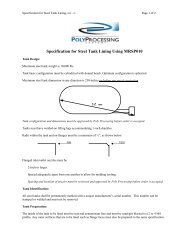Environmental Stress Crack Resistance - Poly Processing
Environmental Stress Crack Resistance - Poly Processing
Environmental Stress Crack Resistance - Poly Processing
Create successful ePaper yourself
Turn your PDF publications into a flip-book with our unique Google optimized e-Paper software.
egion of a cross linked polyethylene sample, we will notice that the tie molecules arenow infinitely connected. The interphase region is now full of these tie molecules thatstrengthen the connections between the adjacent crystal regions. Thus even whenchain scission occurs along the backbone of the tie molecules, the high or infinitedegree of connectivity between the molecular chains is still maintained. This infinitemolecular weight is what gives the cross linked polyethylene material its superior ESCR.If we recall in our earlier discussion, the higher the molecular weight, the higher theESCR for the polyethylene material.In addition to increasing the ESCR’s resistance, the bonds between the moleculesmay have some additional benefits. They may prevent some of the spring back thatdecreases the strength of the interphase regions and allow the cracks to grow. Also,the cross links probably serve as crack arrestors to block the growth of cracks shouldthey begi6- Summary:It is important to note that these relationships between molecular weight, short chainbranching, tie molecules, crystallinity and the ESCR of polyethylene material have beendetermined through experimental analysis and scientific deduction. The scientificcommunity is still in the discovery stage in terms of fully understanding the mechanicsby which each if these factors affect the ESCR of polyethylene. Data from the fieldsuggest that certain polyethylene resin grades perform better than others do. Thisarticle is a simple attempt to explain why this is the case. Future work by the scientificcommunity is still needed to fully understand environmental stress cracking of<strong>Poly</strong>ethylene and polymers in general7- References:1. Peacock, Andrew J. Handbook of <strong>Poly</strong>ethylene, New York, Marcel Dekker Inc. 20002. Strong, A. Brent Plastics: Materials and <strong>Processing</strong>, 2nd edition, New Jersey,Prentice-Hall, Inc. 20003. Moalli, John Plastics Failure: Analysis and Prevention, New York, William AndrewInc. 20014. Hamid S. Handbook of <strong>Poly</strong>mer Degradation, 2 nd edition, New York, Marcel DekkerInc. 20005. Hoekstra, Hielke The Mechanical Behavior of UV-degraded HDPE: Consequencesfor Designers, Netherlands, Delft University Press, 19976. Schellenberg, J. <strong>Environmental</strong> <strong>Stress</strong> <strong>Crack</strong>ing <strong>Resistance</strong> of Blends of High-Density <strong>Poly</strong>ethylene with other polymers, J <strong>Poly</strong>m Eng. and Science, Sept 1998,Vol. 38, No. 9, P 1413-1419.7. Soares, Joao B. P. <strong>Environmental</strong> <strong>Stress</strong> <strong>Crack</strong>ing <strong>Resistance</strong> of <strong>Poly</strong>ethylene: TheUse of CRYSTAF and SEC to Establish Structure-Property relations, J <strong>Poly</strong>m Sci,Part B, 2000,Vol 38, P 1267-1275.8
















